Now is the perfect time to plan a spectacular trail-riding trip to southern Utah’s colorful red rock country. Moab and Kanab in particular offer some of Utah’s most beautiful terrain. Nowhere else on the planet can you find to this extent such a rare combination of red rocks, deserts, mountains, high plateaus, and canyons. Simply put, the area is uniquely stunning, just waiting to be explored. We recently loaded up our Missouri Fox Trotter geldings, Nate and Cowboy, and headed to southern Utah for an unforgettable riding and camping sojourn.
[CHECK OUT: WHERE-TO-RIDE GUIDE]
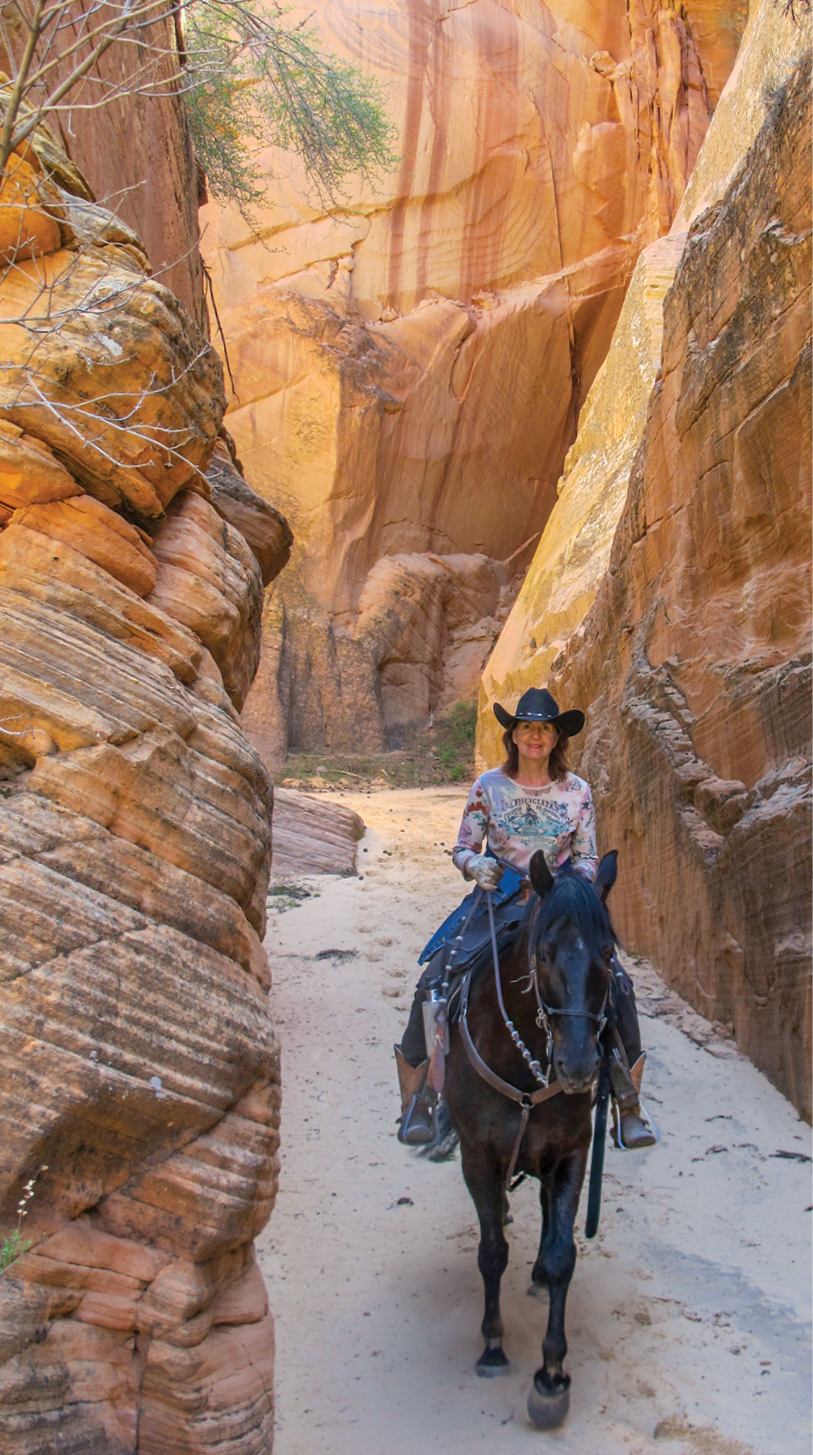
Magical Moab
Moab (discovermoab.com) is a great base of operations for folks who want to explore this region. You may camp at the Spanish Trail Arena (grandcountyutah.net). This nice facility offers covered corrals with hookups. Or, you may camp on a Bureau of Land Management campground; there are three in the Moab area (blm.gov/utah). At the BLM campgrounds, there are corrals but no reliable water.
Through Canyon Lands Back Country Horsemen of Utah (bchu.com/bch-canyonlands.php), we met Richard Coffinberry, who retired to Moab in 2009 after falling in love with the region for its riding potential. His website (moab-horses.com) provides information on rides in the area, complete with trail descriptions and photos. Richard and his 11-year-old mule, Eve, went with us on our rides to Moab’s Mill Canyon and Onion Creek.
Also joining us on the Onion Creek ride was Barb Edmunds who, after retirement, moved to Moab from New York with her horse, Honey, to live the Western dream and ride in red rock country. We then explored the area around Hauer Ranch on our own.
Here’s a rundown of our trail rides in magical Moab.
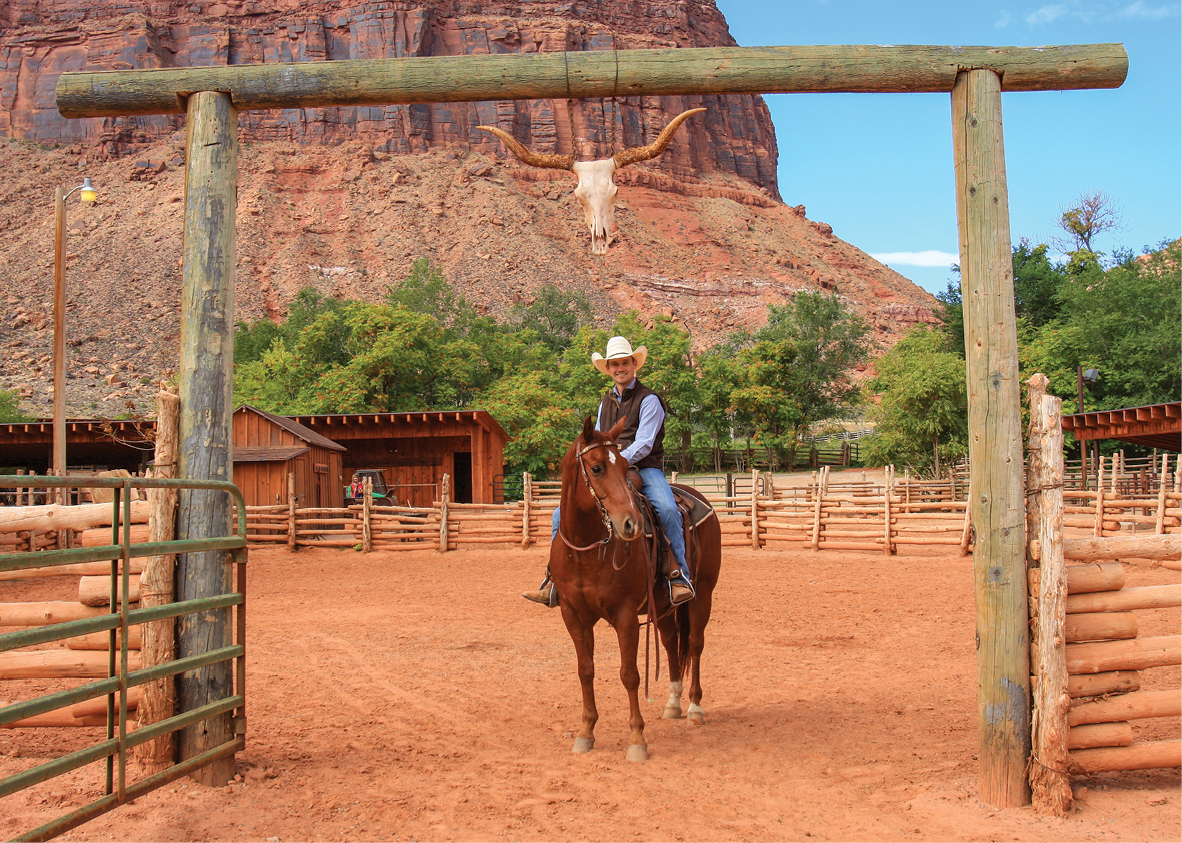
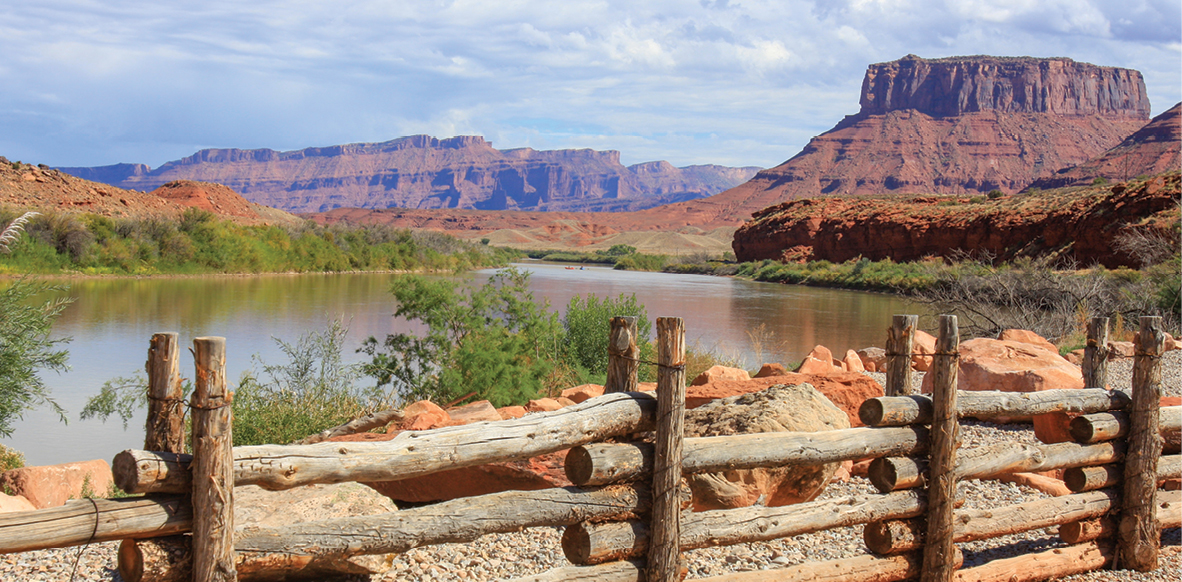
Mill Canyon. To get to our first riding destination, we trailered about 13 miles north of Moab on Hwy. 191, turned left on Mill Canyon Rd., drove about a half-mile to a junction, then turned left and drove another half-mile to a parking lot where we could leave our rig. We unloaded our horses, saddled up, and rode south toward Courthouse Rock. On the left side of the valley, we could see Slickensides Arch. We continued riding south to Halfway Stage Station ruin; in the late 1800s, stagecoach passengers on the way from Moab to the railroad would find rest and refreshment here. Tired horses were exchanged for a fresh team.
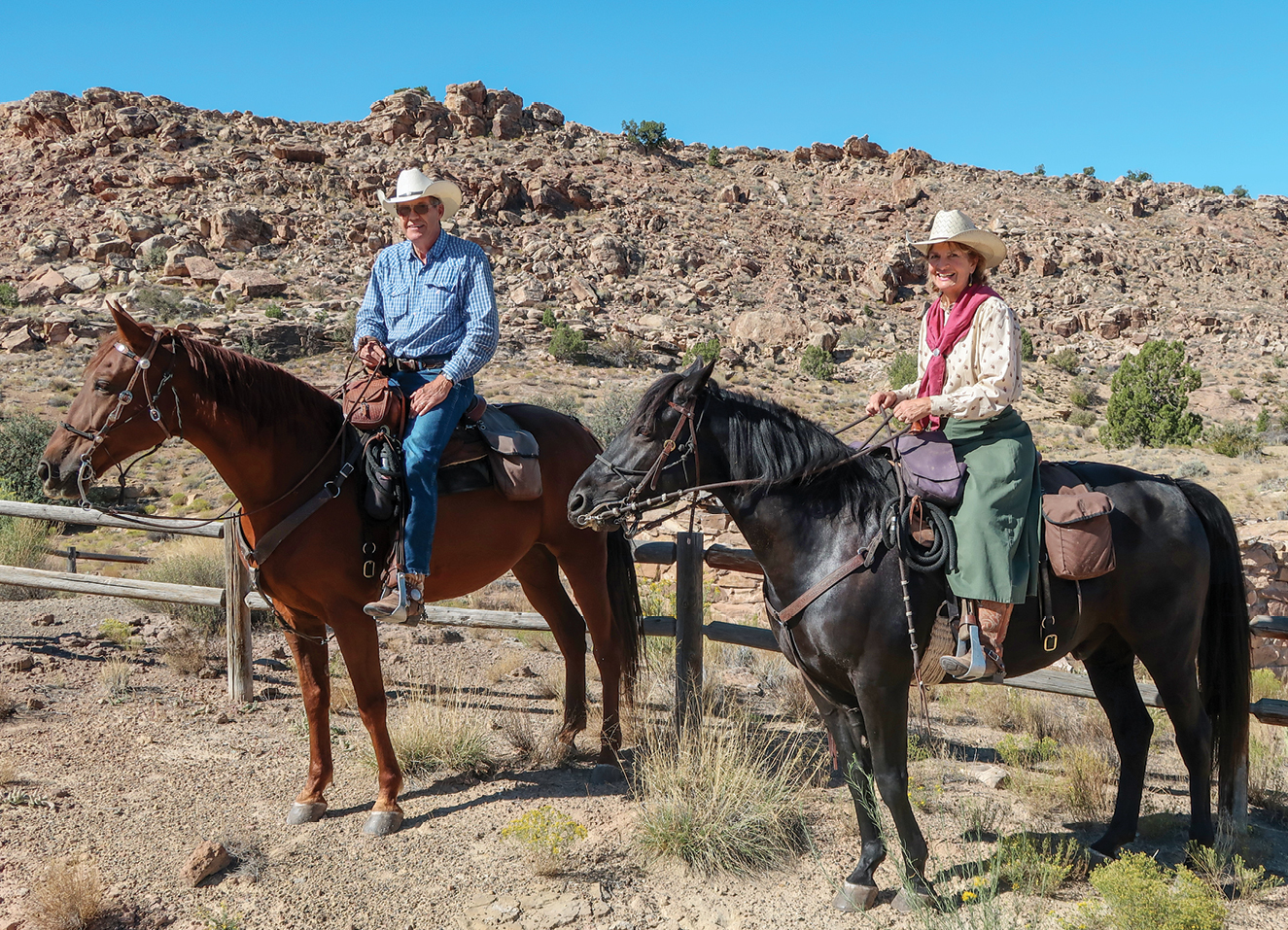
We continued riding south, staying to the right side of the valley. We followed white paint marks on the slab rock trail and kept the red monolithic walls to our right as guideposts to keep us heading south. We rode on top of rock slabs that had at one time been sand and were now hardened into stone.
At the southern end of a red butte, we cut cross-country, riding southeast for about 2 miles in an attempt to find Uranium Arch. (If you do this ride, make note of the buttes behind you; these will guide you back to the main trail.) Richard had told us we wouldn’t be able to see Uranium Arch unless we were almost on top of it. We never found the arch, but we did discover a narrow canyon. We rode to canyon’s edge and looked down into it.
After returning to the monolithic butte, we rode on a large expanse of slab rock following white paint marks around the west side of the butte to Mill Canyon Valley. From the valley, we worked our way to the west side, which made for easier traveling. Riding north was easy on the eyes: Pockets of verdant cottonwoods framed a stream that bubbled between scarlet canyon walls.
We emerged at the parking lot for Mill Canyon. From here, a short walk will take you to see allosaurus and stegosaurus fossils. We then took the road north and cut cross-country back to the trailhead. Our ride formed a perfect loop.
Onion Creek. Our next ride was to Onion Creek. To find the trailhead, drive east from Moab on Hwy. 128. At Mile Marker 20, turn right on Taylor Ranch Rd. After you turn, you’ll see a small sign for Onion Creek. This trailhead features four corrals built by members of the Canyon Lands Back Country Horsemen of Utah. This is a good camping location, but if you plan to camp here, bring water for your horse; the small creek below the camp may be dry.
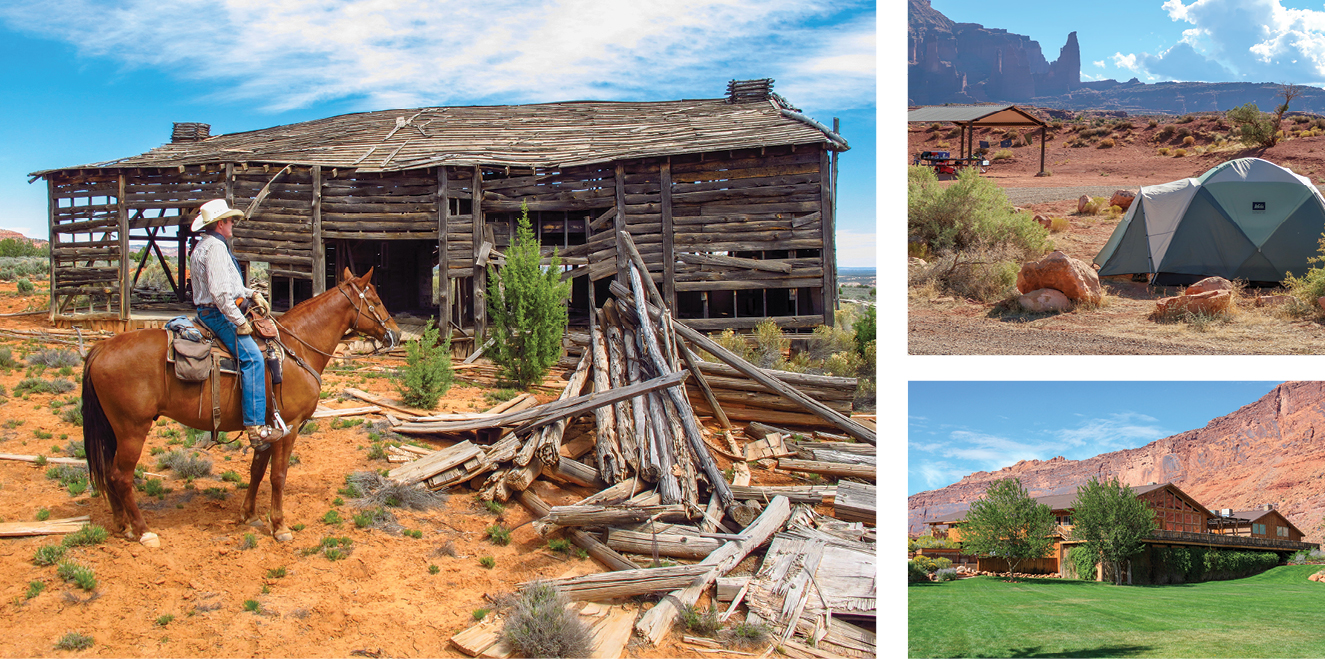
There are several rides from the Onion Creek trailhead, including opportunities for cross-country riding. From camp, we followed the streambed toward the Fisher Towers—prominent red rock towers that rose to great heights in the distance.
More than 100 films, television shows, and commercials have been shot in this picturesque region, most recently scenes for Transformers: Age of Extinction, The Need for Speed, and The Lone Ranger.
Our trail followed the stream up an increasingly narrow red-walled canyon. After about 4.5 miles, the canyon narrowed to a width of about 20 feet. Richard’s mule stepped into quicksand but fortunately escaped after a brief struggle. (Quicksand isn’t common in the area but can be found here as well as in other parts of Utah.) After finding a way up out of the canyon, we located “soft” rocks and enjoyed our lunch, the scenery, and the fine company we were in.
Near Onion Creek is Red Cliffs Lodge (redcliffslodge.com). You can board your horse here and stay at the lodge, which has rooms overlooking the Colorado River, plus restaurants, a swimming pool, and even its own winery.
Of special interest is the lodge’s movie museum, featuring artifacts and information about the movies filmed in the region. The property around the lodge was a key location for many well-known Westerns, including Rio Grande, Cheyenne Autumn, and The Comancheros. Thelma and Louise drove off the cliff near here.
We visited with Devon Dixon, head of the riding program at Red Cliffs Lodge. His father started the program in 2002; he’s proudly following in his father’s footsteps. Devon and three wranglers manage a herd of 29 horses.
Hauer Ranch. Just east of Red Cliffs Lodge is Hauer Ranch (moabhorses.com). Hauer Ranch looks like a scene out of the Old West with rustic wood buildings, boardwalks, flowing rock ridges, and sky-piercing rock towers. Because of its classic Western landscape, the ranch is a popular movie-making destination.
The Hauers specialize in custom-designed trail rides near the Fisher Towers, along the Colorado River, and in Professor Valley. They relish in taking guests via horseback to see the locations for such films as City Slickers and Rio Conchos.
Colorful Kanab
Kanab (kanabguide.com), located just north of the Arizona state line, was founded in 1870 by Latter Day Saints. Today, this small, picturesque town warmly welcomes equestrians.
We went on two rides in the Kanab area. We first rode along the Cottonwood Canyon Trail, closer to town. Then we set up camp at Paria River Ranch and rode along the lower Paria River from there.
Paria River Ranch (pariariverranch.com) is located about 40 miles east of Kanab off Hwy. 89 next to the Paria River at the bottom of the Grand Staircase Escalante National Monument. The ranch’s corrals can house up to 29 horses. There are just a few full hookups, but you may also dry camp. Showers, bathrooms, laundry facilities, and potable water are available onsite.
Here’s a closer look at our rides in the Kanab area.
Cottonwood Canyon Trail. Our first ride was along the Cottonwood Canyon Trail. As we unloaded our geldings, we were impressed by the new Cottonwood Canyon Trail trailhead, built by Kanab’s High Desert Horsemen and the Bureau of Land Management.
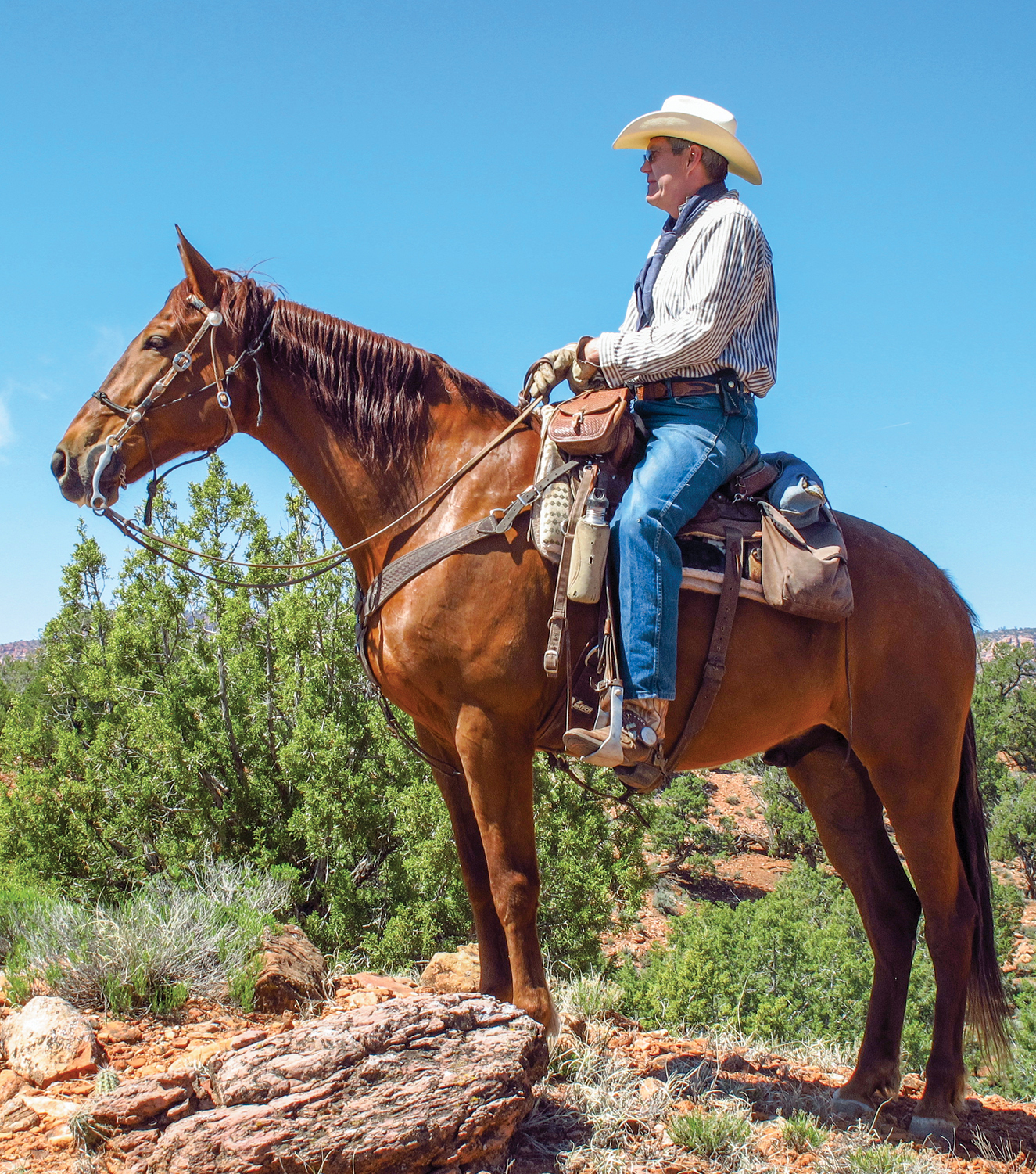
To get to the trailhead, drive to stoplight at the junction of Hwy. 89 and Hwy. 89A, and go south 0.8 miles. On the west side of Hwy. 89A, look for a large sign reading Kanab Creek Ranchos. Just after this sign, turn right (west) on Kanab Creek Dr. You’ll go down into Kanab Creek, then up out of it. At the four-way stop, continue straight. Turn right on Stansfield Dr., and continue west. After the Bunting Trailhead (for hikers only), you’ll see the Cottonwood Canyon Trailhead.
The first, hilly portion of the Cottonwood Canyon Trail takes you through a beautiful Western landscape of red rocks, green pinion pines, and fragrant gray-green juniper bushes. Just before one steep hill, the trail splits to the right. This will take you and your very appreciative horse around the hill instead of straight up it. We figured this out on the way back—much to our horses’ chagrin!
After 1.5 miles, you’ll come upon an iron gate. After the gate, continue on a newly constructed trail, or, for an added delight, detour to an old movie-set fort. This fort was built in 1954 and used until 1979. The Apple Dumpling Gang Rides Again is among the movies filmed here.
To get to the fort, go through the iron gate, and ride along the fence line south until you reach a small rock cairn. Turn right, and follow a very faint trail down into the canyon’s dry creek bed. Follow the creek bed downstream until you reach a large pile of discarded lumber. Just beyond the lumber lie the fort’s remains.
To continue our ride, we retraced our steps back to the lumber pile and headed northwest cross-country toward a huge rock reef. This arid country is tie-dyed in swatches of intense purple, yellow, green, white, orange, and red, inspiring us to call it Crayola Canyon. We took picture after picture but knew that it was impossible to truly capture the area’s magnificence.
After reaching the trail, we rode along the reef’s base and eventually reached a barren, gray, moonscape-like region. We found a lunch spot and had a nice break. Reluctantly, we then mounted up and turned back to the trailhead.
Warning: Give yourself plenty of time for this ride because turning back isn’t easy! We kept wanting to see what amazing scenery lay around the next bend.
Lower Paria River. The 95-mile-long Paria River, a tributary of the Colorado River, flows through a roadless canyon where it has cut deep into the sandstone creating towering walls that rise hundreds of feet on either side of the waterway. Here, you can have a real Western adventure. Meander wherever you like; you’ll find a different wonderland around every turn.
We began our riding adventures from the Paria River Ranch. First, we rode southeast cross-country, passing an abandoned farmhouse. We worked our way over to the river and followed it downstream until we came to a dirt road. You can follow this road a short distance to the trailhead for the main Paria Canyon. But first, you might wish to explore several smaller canyons in the area, including the slot canyons.
A slot canyon is one that becomes very narrow; in a few places, you’ll be able to touch both sides of the canyon walls with your arms outstretched. For some riders, this can feel claustrophobic; for others, this offers an exhilarating photo opportunity.
Avoid riding into slot canyons if there are storm clouds on the horizon and a chance of rain. Flash floods occur quickly and escape may not be possible. Generally, early fall and late spring are the safest times to ride here; most of the flash flooding occurs in July and August.
You might also come across quicksand. To stay safe, cross the river where you see gravel or signs of animal crossings. If the sand appears smooth and jiggly, direct your horse elsewhere.
We rode alongside the Paria River until we came to a section referred to as The Narrows. Here, the canyon’s sides come within 30 feet of each other, and water touches both sides of the canyon walls. It’s about 8 or 9 miles to this point from the Paria River Ranch.
For those with active imaginations, riding along the Paria River provides a plethora of material. Swirling rocks look like whipped cream layered with chocolate, patterns on stones arrange themselves into animals, and conglomerates of arches look as though they could house impish sprites.

Celebrate Western Legends
If you’re interested in the Western movies filmed in Kanab, Utah, don’t miss the Western Legends Roundup (westernlegendsround up.com). Held every August, this event celebrates the Old West and Kanab’s Hollywood heritage. Gunsmoke, Wagon Train, The Lone Ranger, Have Gun Will Travel, and more were filmed in the area. At the festival, you’ll enjoy Western music and entertainment, meet Western movie stars and stunt performers, and peruse Western-themed exhibits. You can also ride your own horse in a wagon train for four days and three nights through John Wayne country, then saddle up for the parade on the event’s last day.

Know Before You Go
Riding in Utah’s red rock country is spectacular, but conditions and terrain can be challenging. Here are our top planning and riding tips for a safe, comfortable adventure.
Plan wisely. The best seasons to ride in Southern Utah are spring and fall. If you plan to bring your horse to the Western Legends Roundup in August, take precautions to keep him (and yourself) cool and hydrated. Avoid Moab in mid-April during the town’s four-wheeler jamboree. Call in advance to check camping conditions.
Condition your horse. Condition your horse for desert riding, which will include traversing rocks, riding through deep sand, and navigating hills.
Schedule the farrier. Get new shoes for your horse, or, if you use hoof boots, have him trimmed just before you go. Hoof protection should be able to hold up on rocky trails.
Pack for extremes. Southern Utah can be hot during the day and chilly at night. Pack a riding wardrobe that allows you to don and doff layers as needed. Also pack brimmed helmets or hats, long-sleeved shirts, and gloves for sun protection.
Consider electrolytes. Ask your veterinarian whether you should supplement your horse’s feed with electrolytes before and on riding days to help replace minerals lost in sweat. Also offer your horse plenty of salt to encourage him to drink.
Pack the saddlebags. Carry a map and GPS device for navigation. Tuck in a broad comb and pliers to remove any cactus spines from your horse’s haircoat. Add a hoof boot, in case your horse loses a shoe. Bring sunscreen, a good lunch, and extra water for yourself.
Watch hydration. Dehydration is the biggest desert danger. There might not be water available for your horse at the trailhead or on the trail. Give him plenty of opportunities to drink before and after the ride. We pack a 65-gallon water tank to water our horses at trailheads.
Watch the weather. Check weather reports for lightning and rainstorms. Storms in the mountains far from your riding location can cause flash floods.
Stay at a walk. Avoid trotting or galloping in deep sand, which could pull a tendon in your horse’s leg. Avoid extending the day longer than what you or your horse is used to.
Watch the soil. Stay on the trail in areas where you see soil with a cryptobiotic crust, which contains a community of living organisms. This crust holds water for plant growth and helps hold the soil in place; if disturbed, it can take this crust 20 to 250 years to grow back.
Watch for quicksand. Quicksand is rare but does occur in the area. Avoid riding into soft, jiggly sand.
Watch for rattlesnakes. We’ve seen many rattlers in the desert, but few have been aggressive. If your horse is bit, seek medical attention as soon as possible.
Share the trail. Moab in particular is noted for mountain biking and all-terrain vehicles. We rode past several of these travelers without any problems, but make sure your horse is used to backpackers and bicycles.






